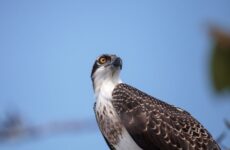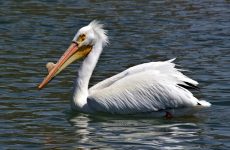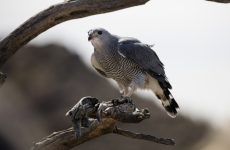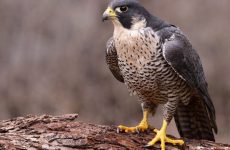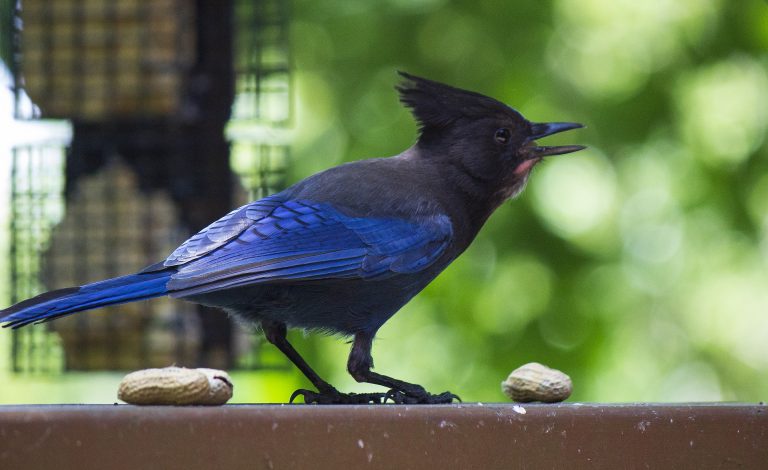
These highly intelligent and widely distributed birds called corvids or crows are known as the smartest birds and include colorful jays, large ravens, magpies, nutcrackers, and crows.
Crows are among the most intelligent of birds and show skills equivalent to a 7-year-old child. They make tools to get bugs out of crevices and even to fish with!
Crows are omnivores and will eat whatever is available and this can cause problems when they target trash and it can give them a bad reputation. They are also associated with death and bad omens in folklore.
There are 11 types of crows in Oklahoma and these include American Crows, Blue Jays, Fish Crows, Common Ravens, Chihuahuan Ravens, Woodhouse’s Scrub-Jays, Black-billed Magpies, Steller’s Jays, Pinyon Jays, Clark’s Nutcrackers, and Canada Jays.
Love them or hate them they are fascinating birds to watch and so check out all the corvids in Oklahoma.
11 Crows in Oklahoma:
1. American Crow
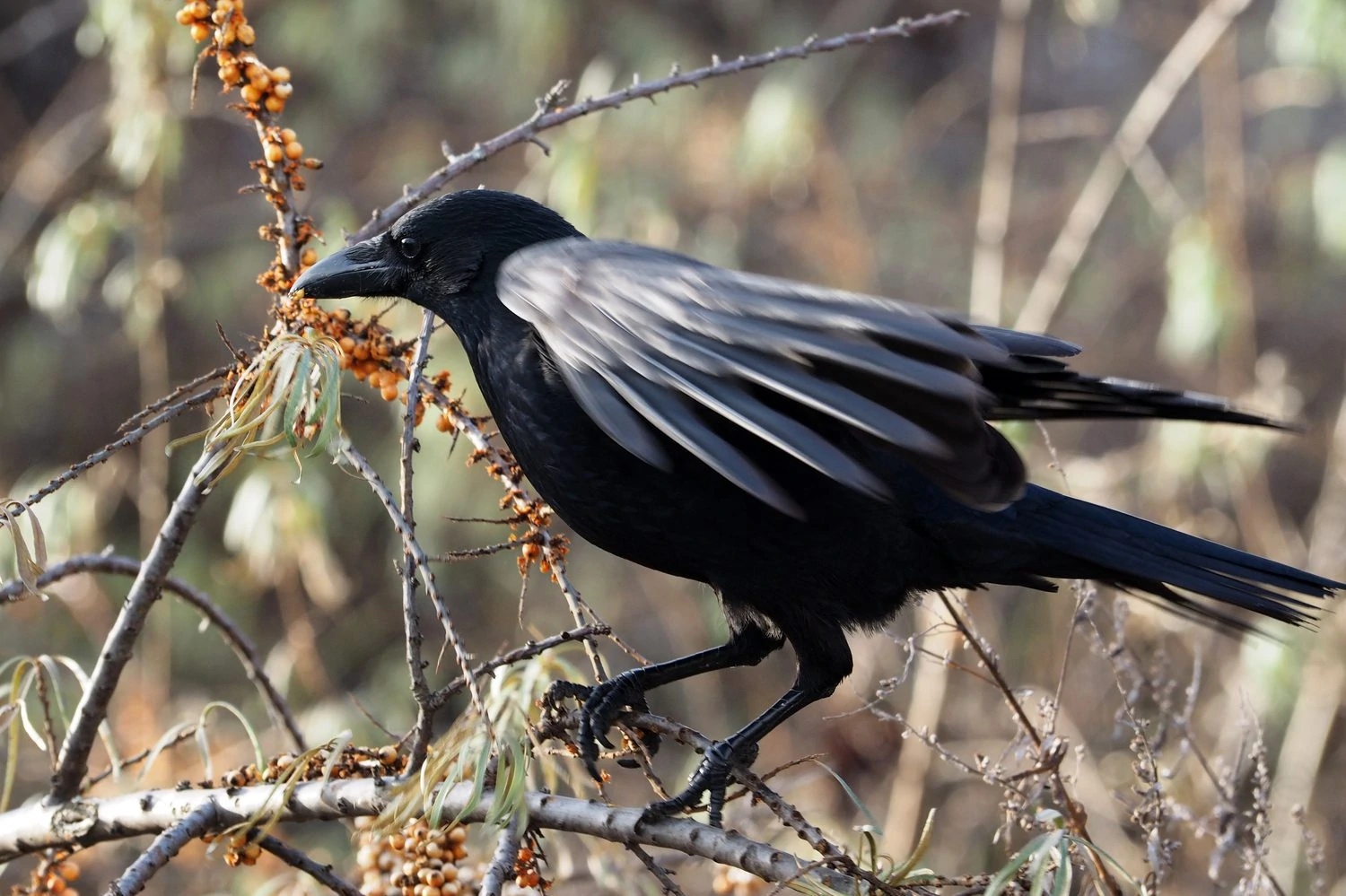
American Crows are very common in Oklahoma and are spotted in the state all year. They are recorded in 33% of summer checklists and 37% of winter checklists submitted by bird watchers for the state.
American crows are large all-black birds, including their legs and bills. They have slightly glossy feathers.
- Corvus brachyrhynchos
- Length: 15.8-20.9 in (40-53 cm)
- Weight: 11.2-21.9 oz (316-620 g)
- Wingspan: 33.5-39.4 in (85-100 cm)
American Crows are residents all year in the lower 48 and the Pacific Coast of Canada and Alaska. Those that breed in Canada and the northern Midwest migrate south for winter.
They are common birds that can be found in most habitats, including treetops, woods, fields, beaches, or towns.
They eat most things and usually feed on the ground, eating earthworms, insects, seeds, and fruit. They also eat fish, young turtles, mussels, and clams and will even eat eggs and nestlings of many species of birds.
American Crow Sounds: They make a hoarse, cawing sound
Nests of American Crows are usually high up in conifers and oak and are made from sticks. They lay 3 – 6 eggs, and these take just under three weeks to hatch and a further five weeks to fledge.
Attract American Crows to your backyard by scattering peanuts, but they can become a nuisance as attracted by garbage or pet food if left out.
Fun Fact: American Crows gather in large numbers of up to two million crows in winter to sleep in communal roosts.
2. Blue Jay
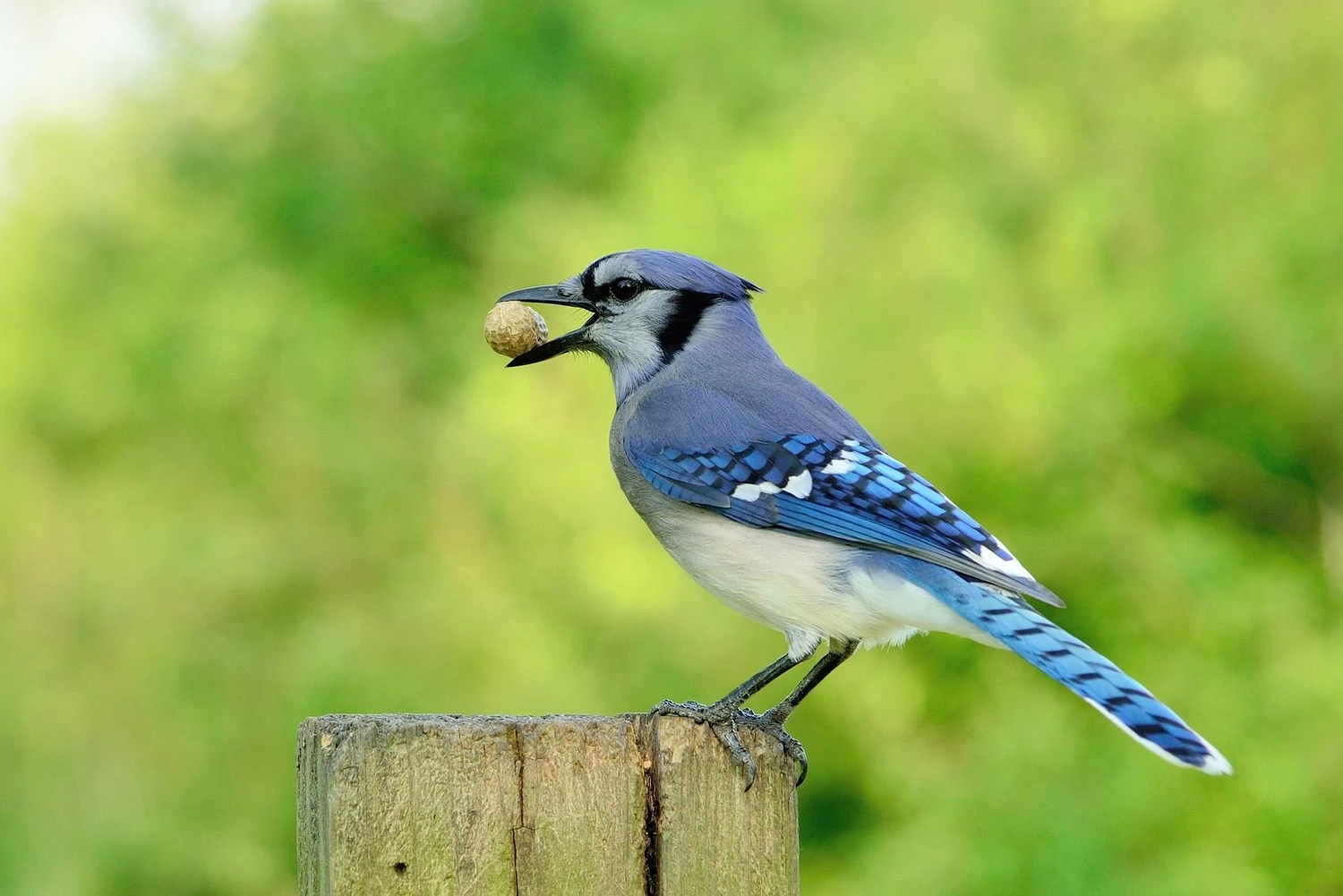
Blue Jays live in Oklahoma all year round. They are spotted in 29% of summer checklists and 34% of winter checklists.
Blue Jays are common large songbirds with a blue upright crest, blue and black backs, and white undersides.
- Cyanocitta cristata
- Length: 9.8-11.8 in (25-30 cm)
- Weight: 2.5-3.5 oz (70-100 g)
- Wingspan: 13.4-16.9 in (34-43 cm)
Blue Jays live in eastern US states and Southern Canada all year. Some birds will migrate west for winter but not very frequently.
They are noisy birds that travel in family groups eating acorns when available. They can be found in forests, especially near oak, as they eat acorns. They can also be found in backyards near feeders.
As well as acorns, they eat insects, nuts and seeds, and grain. They may also take eggs from nests or take nestlings.
Blue Jay sounds: They usually make a variety of quite harsh calls using clicks, peeps, ‘caws’, and whistles. Blue Jays also have a gentle fluted song during courtship.
Blue Jays are large birds and prefer to fly in, grab a peanut or sunflower seed and take it away to feed. They prefer platform or tray feeders to make it easy to make a quick exit.
Attract Blue Jays to your backyard with peanuts, sunflower seeds, and suet on tray feeders or hopper feeders on a post. They will also enjoy a birdbath.
Fun fact: Blue Jays will play with shiny objects such as aluminum or bottle caps, and they will carry them around, dropping them and picking them up.
3. Fish Crow
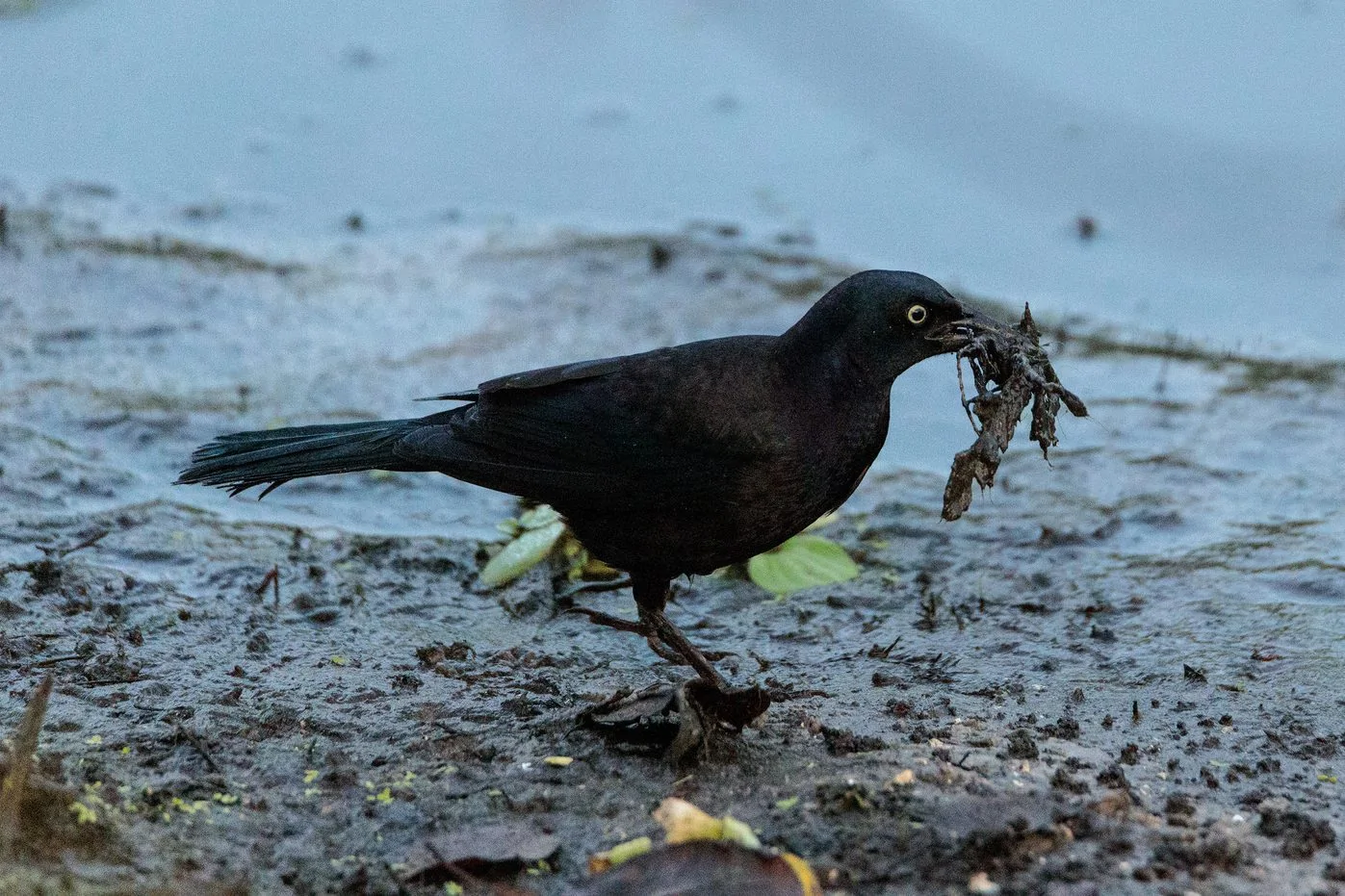
Fish Crows spend the breeding season in the east of Oklahoma but some hang around all year in the southeast of the state. They appear in 10% of summer checklists.
Fish Crows look the same as American Crows, with all black glossy coloring and strong, sturdy bodies. Only their calls are different. They have slightly rough throat feathers, which they puff out when calling. Males and females look the same.
- Corvus ossifragus
- Length: 14.2-15.8 in (36-40 cm)
- Weight: 6.9-11.6 oz (195-330 g)
- Wingspan: 33.1 in (84 cm)
Fish Crows are resident along the east coast from Texas up to Maine. They will occasionally move short distances in winter.
You can find Fish Crows near water, including beaches, rivers, and marshes. Like most crows, they are also often found near humans as they will eat most things, not just fish as their name would suggest. Grain, fruit, eggs, and baby birds, are all on the menu, as well as crabs and other marine life.
Fish Crow sounds: A typical crow ‘caw,’ but more nasal than the American Crow.
Nests of Fish Crows are in trees or mangroves and are made from bundles of sticks and filled with mud and softer material such as moss, pine needles, and bark.
They lay 2 – 6 eggs, and these take around two and a half weeks to hatch and a further four to five weeks to fledge.
Fun Fact: Fish Crows form massive, noisy flocks in their hundreds of thousands in winter.
4. Common Raven
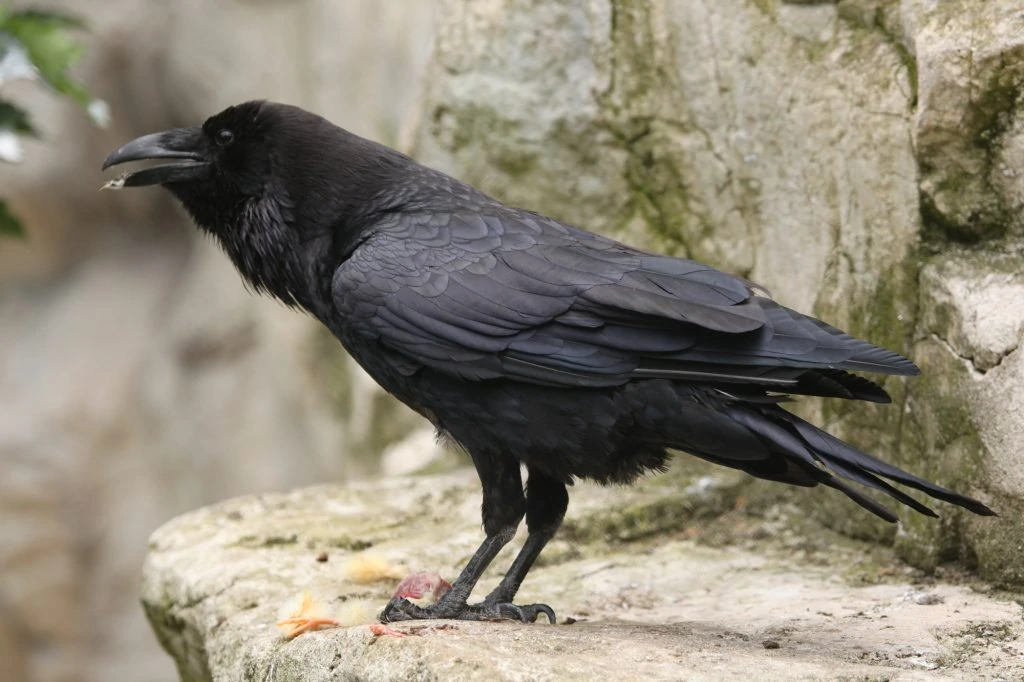
Common Ravens do not migrate and are spotted in the northwest of Oklahoma all year.
Common Ravens are thought to be one of the smartest and definitely one of the largest species in the songbird family. They have shaggy throat feathers, large black beaks, and wedge-shaped tails.
- Corvus corax
- Length: 22.1-27.2 in (56-69 cm)
- Weight: 24.3-57.3 oz (689-1625 g)
- Wingspan: 45.7-46.5 in (116-118 cm)
Common Ravens are resident in Canada, western US states, northeastern US states, Mexico, and northern Central America. They are not found in the Great Plains or eastern US states.
You can find Common Ravens in most places, and they especially follow humans. Forests, beaches, fields, grasslands are all places to find them and rural human areas. They are not common in towns and cities as American Crows take over.
Not known as picky eaters, Common Ravens will eat most things, including any small animals, eggs and nestlings, plus insects and fish. Human rubbish and pet food
Common Raven sounds: Mostly croaks and harsh calls
Nests of Common Ravens are usually relatively high up on cliffs, trees, bridges, and towers. Their nests are made from long sticks and are large, up to 5 feet across and 2 feet high. The inside of the nest will be lined with mud and softer material, such as grass and wool.
Common Ravens lay up to seven eggs, and they take around three weeks to hatch and about five weeks to fledge.
Fun Fact: Common Ravens in Canada weigh up to 60% more than those in California.
5. Chihuahuan Raven
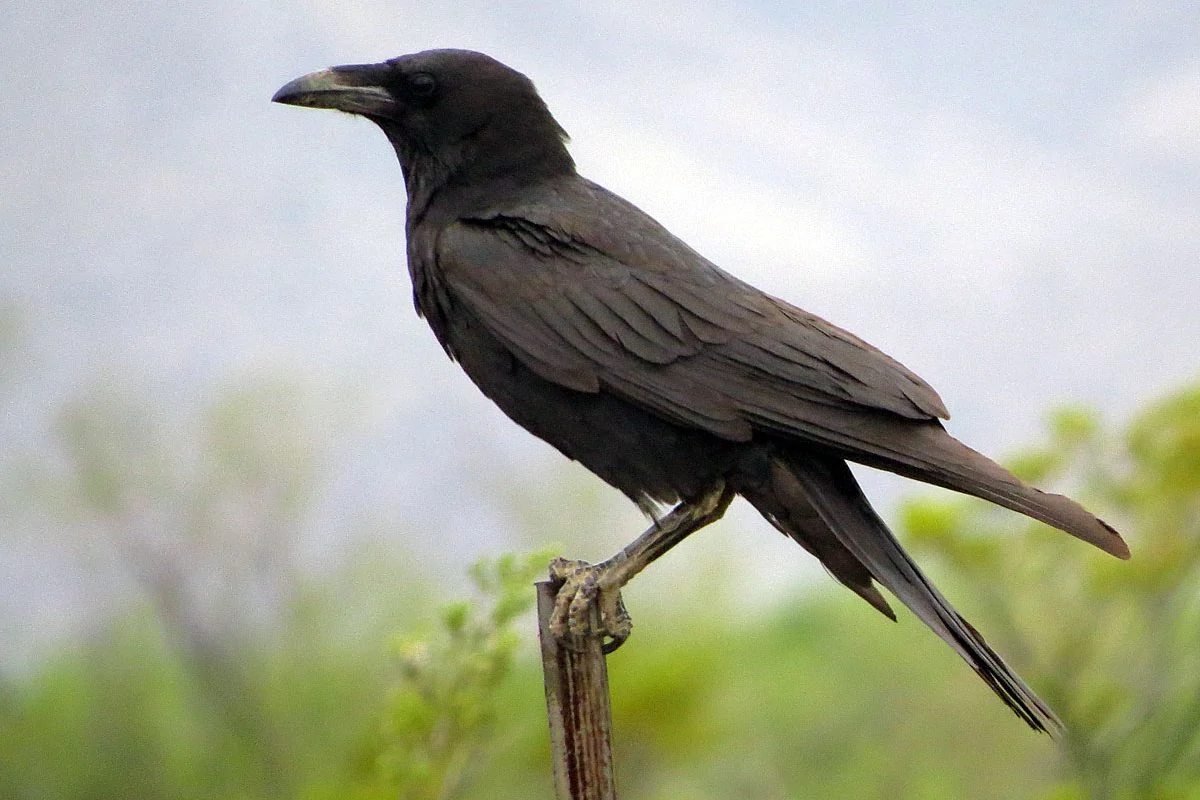
Chihuahuan Ravens are not very common in Oklahoma but some have been spotted in the west of the state all year.
Chihuahuan Ravens are very similar in appearance to Common Ravens but with longer tails, and they are smaller and more similar in size to American Crows. They are all black, including the black bill and legs. They also have a slight glossy purple color.
- Corvus cryptoleucus
- Length: 18.1-20.9 in (46-53 cm)
- Weight: 15.6-23.5 oz (442-667 g)
- Wingspan: 40.9-43.3 in (104-110 cm)
Chihuahuan Ravens are resident in the American southwest from Arizona to Texas and northern Mexico.
You can find Chihuahuan Ravens in dry grassland and deserts where American Crows do not usually live.
They eat a wide variety of food and are opportunity feeders, often foraging on the ground for insects, worms, spiders, and fish, and larger roadkill prey such as reptiles and mammals. Grains, fruit, and seeds are also eaten, and they will happily eat trash for an easy meal.
Chihuahuan Raven sounds:
Nests of Chihuahuan Ravens are quite large and made from sticks, and lined with softer material such as feathers, cotton, and plant material.
They lay 1 – 8 eggs, and these take just under three weeks to hatch and a further five weeks before the chick fledge.
Fun Fact: Chihuahuan Ravens perform barrel rolls in flight during courtship.
6. Woodhouse’s Scrub-Jay
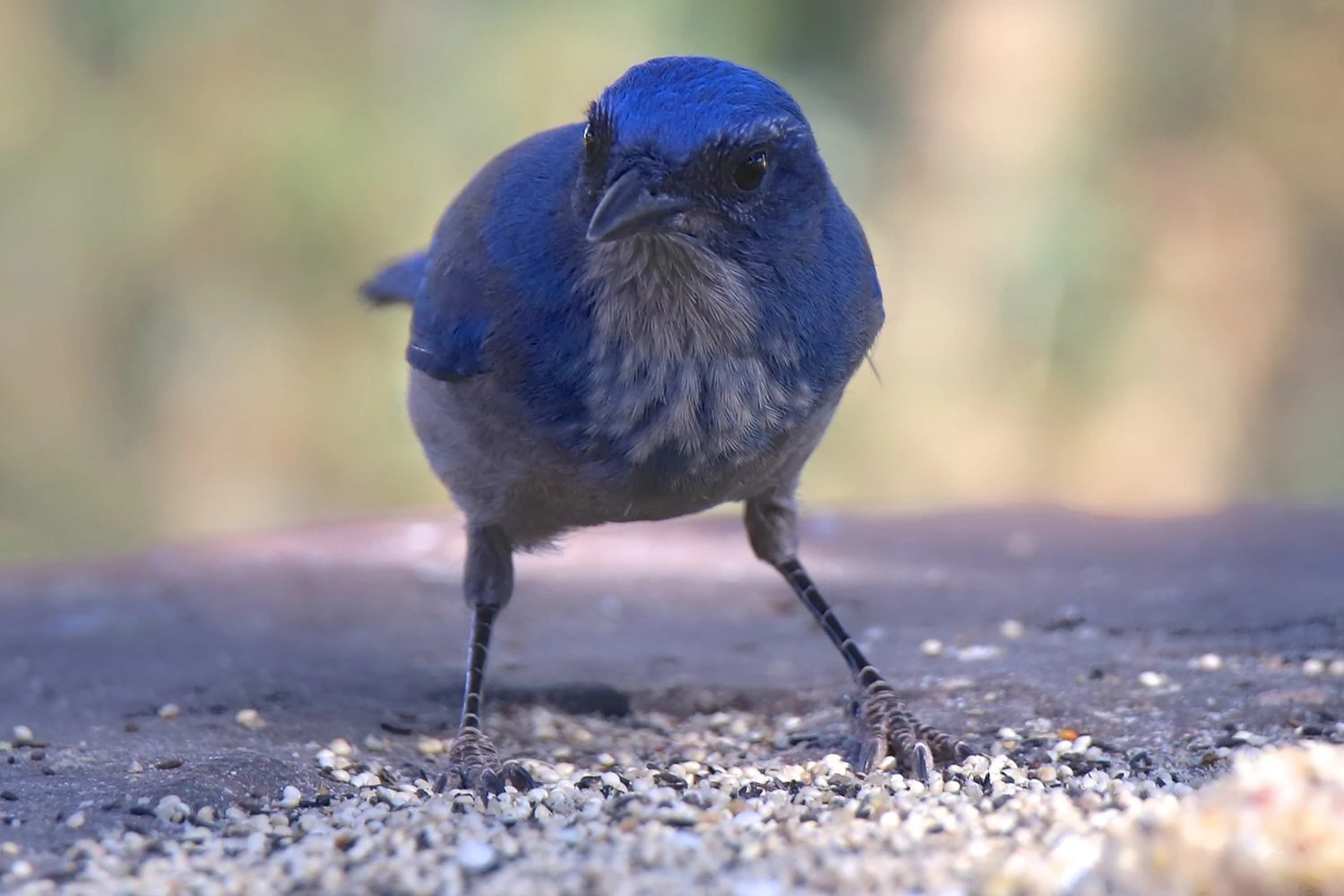
Woodhouse’s Scrub-Jays are occasionally spotted in the northwest of Oklahoma but they are not very common here.
Woodhouse’s Scrub-Jays are the Blue-Jays of the Southwest with lovely blue and gray coloring. They are light blue and dark gray on the back and light gray underneath. Their tails are long and blue.
They are duller in color than California Scrub-Jays and have only a small necklace, and lack the crests of Blue Jays and Stellar’s Jays.
- Aphelocoma woodhouseii
- Length: 11.0-11.8 in (28-30 cm)
- Weight: 2.5-3.5 oz (70-100 g)
Woodhouse’s Scrub-Jays are resident inland in southwest US states and Mexico. You can find them in wooded areas with pinyon-juniper and scrubby areas.
Insects and fruit make up most of the diet of Woodhouse’s Scrub-Jays in summer and nuts and seeds in winter.
Woodhouse’s Scrub-Jay sounds:
Nests of Woodhouse’s Scrub-Jay are fairly simple platforms made of twigs and lined with moss and grass.
Attract Woodhouse’s Scrub-Jays to your backyard with sunflower seeds and peanuts.
Fun Fact: Woodhouse’s Scrub-Jays are thieves that steal food from other birds stores, especially Acorn Woodpeckers’ granary tree store of acorns.
7. Black-billed Magpie
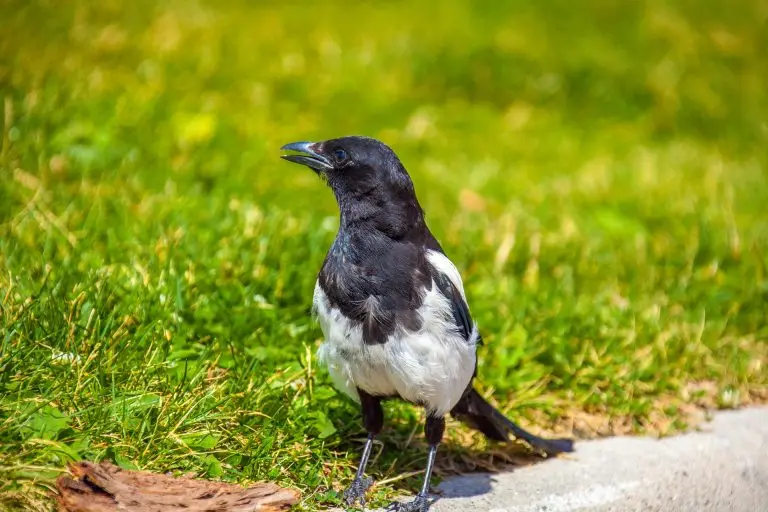
Black-billed Magpies are not often spotted in Oklahoma but there have been some occasional sightings in the northwest of the state all year.
Black-billed Magpies, usually just called Magpies, are black and white birds that are noisy. They have long tails and blue-green iridescent flashes in the wing and tail. Males are up to 25% heavier than females.
- Pica hudsonia
- Length: 17.7-23.6 in (45-60 cm)
- Weight: 5.1-7.4 oz (145-210 g)
- Wingspan: 22.1-24.0 in (56-61 cm)
Black-billed Magpies live in northwestern US states and western Canada, and the coast of Alaska. They do not migrate.
You can find them walking on the ground in meadow and grasslands or other open areas feeding on fruit and grain, beetles, and grasshoppers. They have also been known to kill small mammals such as squirrels and voles and raid bird nests for eggs or nestlings and even carrion.
Black-billed Magpie sounds: A series of harsh calls and also a scream.
Nests of Black-billed Magpies are a messy ball-shaped collection of twigs with a neat cup of mud and soft material on the inside. They lay 6 – 7 eggs, and these take around three weeks to hatch and fledge a further 3 – 4 weeks.
You can attract Black-billed Magpies to your backyard with platform and suet feeders with black oil sunflower seeds, peanuts, fruit, suet, millet, and milo.
Fun Fact: A gathering of magpies calling around one of their dead is called a funeral.
8. Steller’s Jay

Steller’s Jays are not very common in Oklahoma but they have been usually spotted around Kenton.
Steller’s Jays are large songbirds with black triangular crests that stick up from their heads. The rest of their heads and onto their chests and back are black, with the rest of their bodies being blue.
- Cyanocitta stelleri
- Length: 11.8-13.4 in (30-34 cm)
- Weight: 3.5-4.9 oz (100-140 g)
- Wingspan: 17.3 in (44 cm)
Steller’s Jays are resident in western US states, western Canada, Mexico, and Central America.
You can find Steller’s Jays in evergreen forests in the mountains, and they will also be found around picnic tables, campgrounds, and backyard feeders.
Steller’s Jays eat most things they can forage for, including insects, seeds, nuts, berries, eggs, and nestlings, but also making a nuisance of themselves around garbage and your unguarded picnic!
Steller’s Jay sounds: They make ‘kaw’ sounds as well as fast two-toned calls, peeps, and harsh guttural sounds. Steller’s Jays can also mimic other noises such as other bird species and even sprinklers and alarms.
Nests of Stellar’s Jays are usually near the top of conifer trees and are built from leaves and plant material held together with mud and lined with soft pine needles.
Attract Steller’s Jays to your backyard with peanuts and suet.
Fun fact: Stellar’s Jays make nests out of the mud.
9. Pinyon Jay
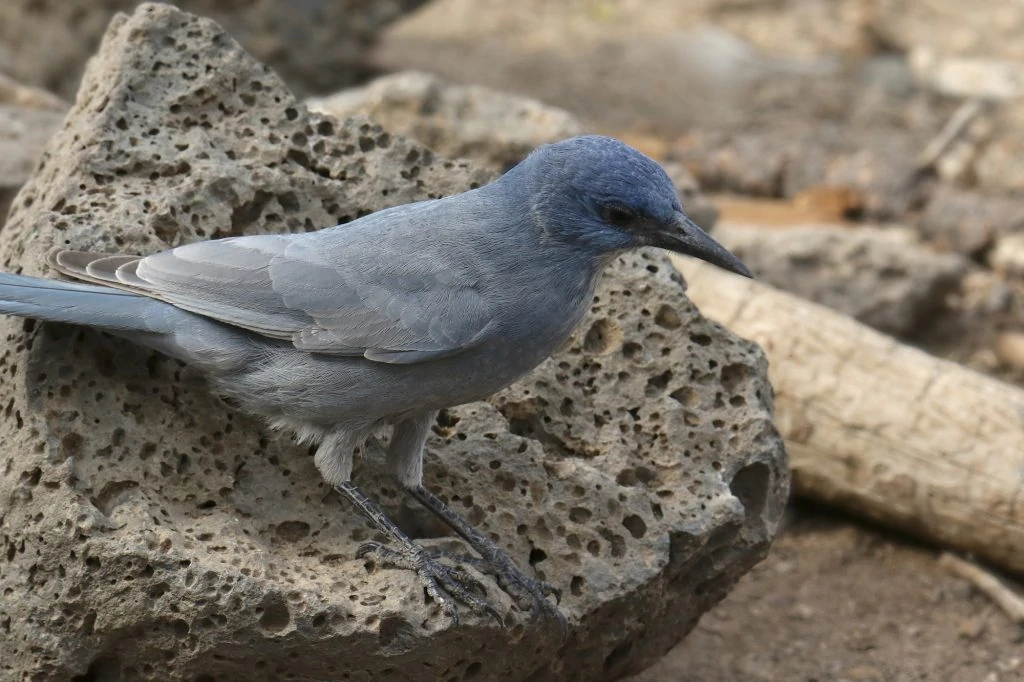
Pinyon Jays are considered vulnerable species in Oklahoma but they can occasionally be spotted around Kenton.
Pinyon Jays are blue all over, with darker backs and paler bellies. They also have white throats, shorter tails, and do not have crests like other Jays, like Stellar’s Jays. Males and females look the same, but juveniles can look more grayish-blue.
- Gymnorhinus cyanocephalus
- Length: 10.2-11.4 in (26-29 cm)
- Weight: 3.2-4.2 oz (90-120 g)
- Wingspan: 18.1 in (46 cm)
Pinyon Jays are residents inland in western US states in pinyon-pine forests.
As well as seeds from pinyon-pine, Pinyon Jays will eat juniper berries, acorns, and other animals such as lizards, baby birds, and insects. They are opportunity feeders who will take most things and forage in large, noisy groups.
Pinyon Jay sounds: They make 3 ‘kaw’ like calls close together that rise and then fall and sometimes shake or tremble.
Nests of Pinyon Jays are built of sticks and grass in pine trees and lined with feathers and animal hair.
Fun fact: Pinyon Jays do not have feathers over their nostrils to prevent the sticky pine pitch from making them dirty.
10. Clark’s Nutcracker
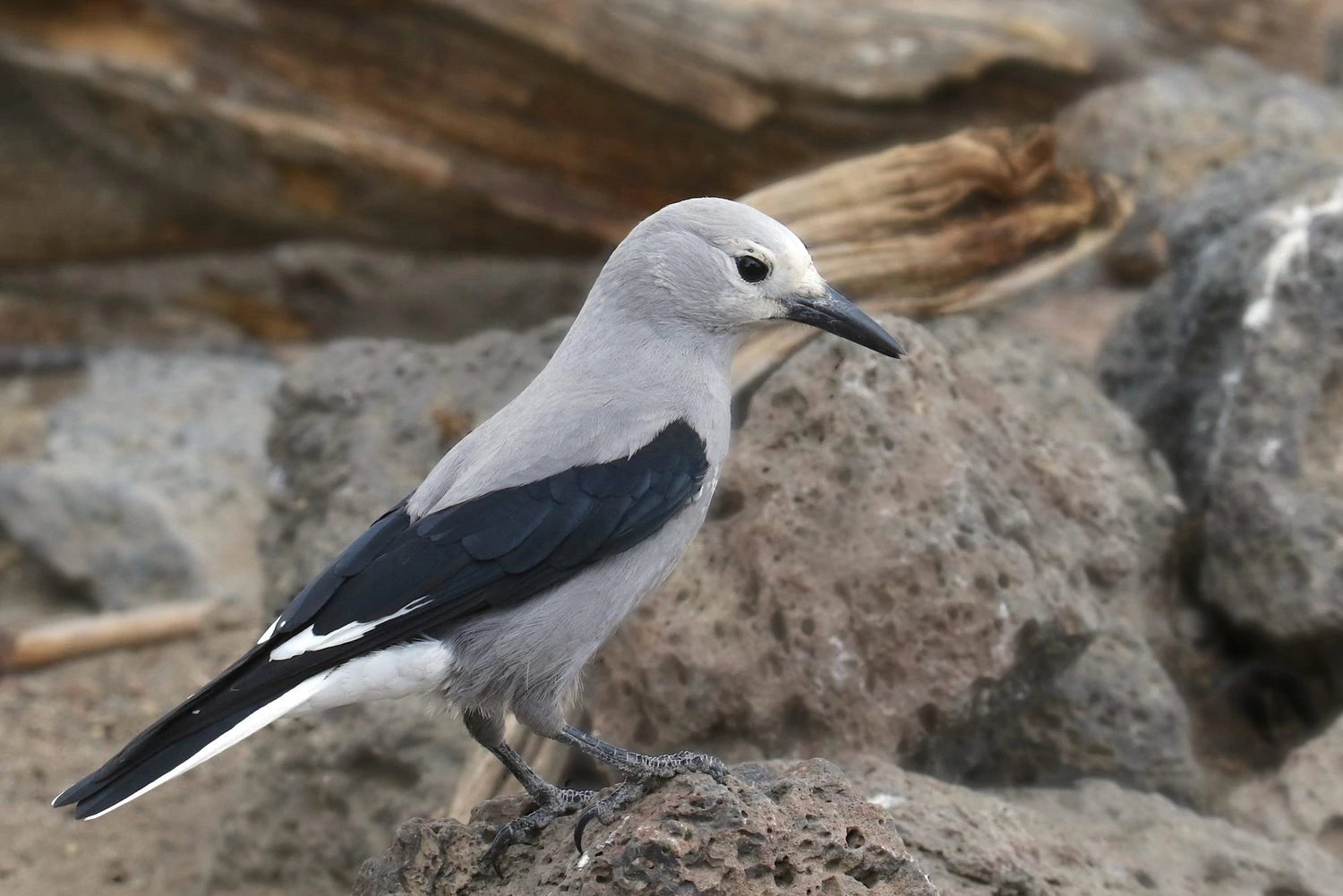
Clark’s Nutcrackers are considered accidental species in Oklahoma, and according to records, they have only been spotted here once, around Black Mesa Nature Preserve in 2017.
Clark’s Nutcrackers are similar in appearance to Canada Jays, with the gray coloring. They have shorter tails than jays and lack the crest. Clark’s Nutcrackers are light gray with black wings and tails with white patches.
- Nucifraga columbiana
- Length: 10.6-11.8 in (27-30 cm)
- Weight: 3.7-5.7 oz (106-161 g)
Clark’s Nutcrackers can be found all year in the pine forests of the mountainous west. They do not migrate but do move up to higher altitudes in the summer, and if pine crops are poor, they will move large distances.
Clark’s Nutcrackers mainly eat pine seeds fresh from the tree or those they have hidden away previously. They will occasionally eat insects, spiders, or small mammals if they get a chance.
Clark’s Nutcracker sounds:
Nests of Clark’s Nutcrackers are made in conifer trees and are made from sticks and twigs and lined with wood pulp, followed by soft dry grass and moss.
They lay 2 – 6 eggs, and these take around two and a half weeks to hatch and a further three weeks to fledge.
Attract Clark’s Nutcrackers to your backyard with black oil sunflower seeds, peanuts, and suet.
Fun Fact: Clark’s Nutcrackers have been recorded as far as Northeastern US states, when cone crops are poor, a distance of up to 2000 miles!
11. Canada Jay
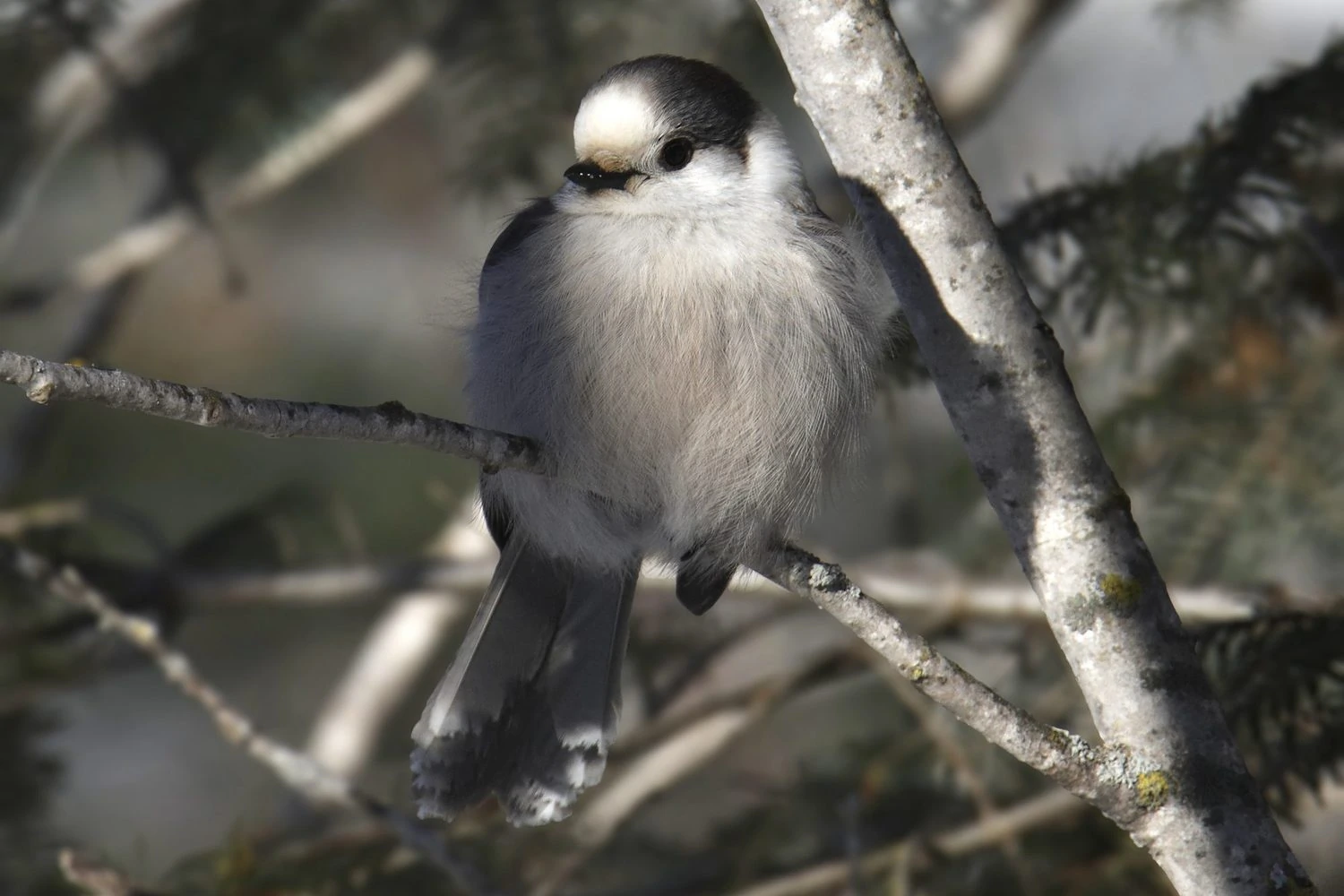
Canada Jays are extremely rare birds to see in Oklahoma but they have been accepted by the Oklahoma Ornithological Society, with some recorded sightings in the state.
Canada Jays are dark gray on the back and a soft pale gray below. They have white heads and throats, with a black band running around the back of the head.
They are sometimes known as Grey Jays. Females look the same as males, but juveniles are darker gray all over.
- Length: 9.8-11.4 in (25-29 cm)
- Weight: 2.0-3.0 oz (58-84 g)
Canada Jays are resident in Canada, Alaska, and the high mountains of the northwest US. Some color differences occur with Canada Jays from different areas. With those in the Rockies being paler than those in Canada.
You can find Canada Jays in boreal forests where spruce trees are common. They are not as loud as other Jays and are opportunity feeders, eating a wide variety of food, including insects, berries, and dead animals. They will also come close looking for food dropped by hikers.
Although they look sweet, Canada Jays have a deadly side, and they will kill baby birds for food and even hunt smaller species such as chickadees and warblers.
Canada Jay sounds: They have a gentle whispered song but often make harsher calls and clatters. Canada Jays can also imitate other species.
Nests of Canada Jays are built early in conifers when there is still snow around. The nest is made from dead twigs and is lined with feathers and built on the south side of the tree for warmth.
Attract Canada Jays to your backyard with most kinds of bird food, such as seeds and suet, and they will readily eat from tube or platform feeders.
Fun fact: Canada Jays produce special saliva, which they use to mold food into a sticky blob, and then they stick it in a hiding place like gum under a desk.

